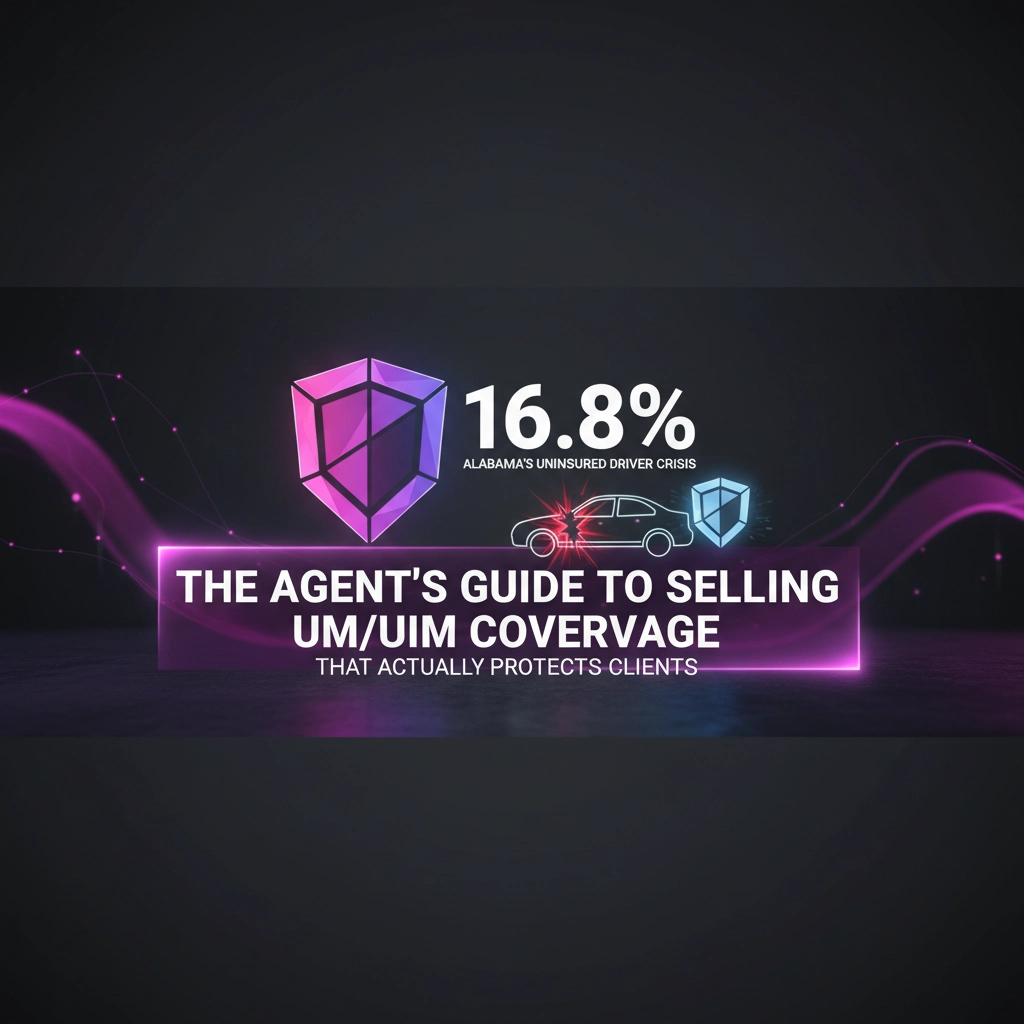Alabama's uninsured motorist crisis presents both a significant risk to drivers and a substantial opportunity for insurance agents who understand how to position uninsured/underinsured motorist (UM/UIM) coverage effectively. With approximately 16.8% of Alabama drivers operating vehicles without insurance, the state ranks among the top ten nationally for uninsured driver rates, creating a compelling case for comprehensive UM/UIM protection.
The Statistical Reality Behind Alabama's Uninsured Driver Problem
Recent data reveals that nearly one in six Alabama drivers lacks mandatory liability insurance, placing the state's uninsured rate significantly above the national average of 12.6%. This statistic translates to approximately 860,000 uninsured vehicles on Alabama roads daily, creating substantial financial exposure for insured drivers who assume adequate protection exists across all motorists.
The economic impact extends beyond individual accidents. Alabama's high uninsured rate correlates with increased insurance premiums for compliant drivers, as carriers factor uninsured motorist claims into their pricing models. Insurance Research Council data indicates that states with elevated uninsured rates typically experience 15-20% higher premium costs across all coverage types.

Understanding Alabama's UM/UIM Legal Framework
Alabama law mandates that every liability insurance policy automatically include uninsured motorist coverage equal to the bodily injury liability limits, with a minimum of $25,000 per person and $50,000 per accident. However, policyholders may reject this coverage through written declination, creating a critical decision point where agent guidance becomes essential.
The automatic inclusion mechanism means most Alabama drivers carry baseline UM coverage without actively considering its adequacy. This presents agents with an educational opportunity to demonstrate why minimum limits often fall short of providing meaningful financial protection in serious accident scenarios.
Property damage uninsured motorist coverage operates separately from bodily injury UM coverage and is not automatically included unless specifically requested. This distinction frequently creates coverage gaps that leave clients vulnerable to out-of-pocket vehicle repair costs when struck by uninsured drivers.
The Coverage Gap: Why Minimums Fail to Protect
Alabama's $25,000 minimum UM coverage was established decades ago and has not been adjusted for medical cost inflation. Current emergency room visits for moderate injuries typically range from $15,000 to $35,000, while complex trauma cases can exceed $100,000 before accounting for rehabilitation, lost wages, or pain and suffering damages.
Analysis of Alabama accident claims data reveals that 68% of uninsured motorist claims exceed the state-mandated minimum coverage limits. This statistic highlights the frequency with which minimum UM coverage proves inadequate, leaving policyholders personally liable for substantial medical and rehabilitation expenses.
The underinsured motorist component presents additional complexity. While approximately 16.8% of Alabama drivers carry no insurance, an estimated 35% of insured drivers maintain only state minimum liability limits. These minimal limits create situations where at-fault drivers technically have insurance but insufficient coverage to compensate serious injury victims adequately.

Strategic Approaches to UM/UIM Sales Conversations
Successful UM/UIM sales require reframing the coverage from an optional add-on to essential personal protection. Research indicates that clients respond more positively when agents position UM/UIM coverage as extending their own liability limits to protect themselves, rather than emphasizing protection against "bad drivers."
Data-driven presentations prove most effective. Agents should present specific cost scenarios that demonstrate how minimum UM limits would perform in realistic accident situations. For example, a moderate rear-end collision requiring emergency surgery, three days hospitalization, and six weeks of physical therapy typically generates combined costs of $45,000 to $65,000 before considering lost wages.
Premium cost comparisons provide powerful closing tools. Increasing UM/UIM coverage from Alabama's $25,000/$50,000 minimum to $100,000/$300,000 typically costs an additional $15-25 per six-month policy term. When presented as daily cost: approximately 8-12 cents per day: the value proposition becomes compelling.
Addressing Common Client Objections
The "I'm a safe driver" objection requires careful redirection. Safe driving habits cannot prevent other drivers from causing accidents, and Alabama's statistical reality means encountering an uninsured driver is a matter of probability, not possibility. Agents should acknowledge the client's driving record while emphasizing that UM/UIM coverage protects against risks beyond their control.
Budget concerns often arise when discussing higher UM/UIM limits. Effective agents demonstrate that the modest premium increase represents significantly less financial exposure than the potential out-of-pocket costs following an uninsured motorist accident. Concrete cost comparisons: additional premium versus potential medical bills: typically resolve budget objections.
The "my health insurance will cover medical bills" misconception requires educational intervention. Health insurance may cover medical expenses but typically excludes lost wages, pain and suffering, or additional living expenses. UM coverage provides comprehensive protection that supplements rather than duplicates health insurance benefits.

Hit-and-Run Scenarios: The Hidden UM Value
Alabama experiences approximately 3,200 hit-and-run accidents annually, with 85% involving uninsured or unidentified drivers. These incidents highlight UM coverage's value beyond traditional uninsured motorist scenarios, as hit-and-run situations often leave victims without recourse unless adequate UM protection exists.
Property damage UM coverage becomes particularly valuable in hit-and-run situations involving vehicle damage. Without property damage UM coverage, victims must rely on collision coverage and pay applicable deductibles. With property damage UM coverage, repairs proceed without deductible requirements, assuming the hit-and-run driver would have been found at fault.
Business Case for Increased UM/UIM Sales Focus
From an agency perspective, emphasizing UM/UIM coverage generates multiple business benefits beyond immediate commission opportunities. Clients who purchase adequate UM/UIM coverage experience fewer claim disputes and demonstrate higher satisfaction rates with their insurance experience.
Retention statistics support this approach. Clients who work with agents providing comprehensive coverage analysis and recommendations show 23% higher retention rates than those who receive transactional service focused primarily on price competition. This correlation suggests that clients value guidance and protection over purely price-driven relationships.
Professional liability considerations also support comprehensive UM/UIM discussions. Documenting coverage recommendations and client decisions provides protection against potential errors and omissions claims while demonstrating professional standards and client advocacy.

Technology Integration and Sales Efficiency
Modern insurance technology platforms enable agents to quickly model different UM/UIM scenarios and present visual comparisons of coverage options. InsureScan's digital tools allow agents to demonstrate coverage gaps and premium differences instantly, supporting more consultative sales conversations without extending appointment durations.
Mobile-enabled quote comparisons prove particularly effective during client meetings. Agents can adjust UM/UIM limits in real-time, showing immediate premium impacts while maintaining conversation flow. This technological capability transforms abstract coverage discussions into concrete financial decisions.
Documentation and Compliance Requirements
Alabama requires written declination for clients who reject available UM coverage. Proper documentation protects both agents and clients by creating clear records of coverage discussions and decisions. Best practices include maintaining copies of signed declination forms and coverage recommendation summaries.
When clients select UM/UIM limits below agent recommendations, documentation should include the specific limits recommended, reasons for the recommendation, and acknowledgment that the client chose different coverage levels despite professional guidance.
Market Opportunities in Alabama's Insurance Landscape
Alabama's elevated uninsured driver rate creates ongoing market opportunities for agents who position themselves as protection specialists rather than price competitors. State-specific market insights demonstrate that clients increasingly value comprehensive coverage guidance as accident costs continue rising.
The combination of high uninsured rates, increasing medical costs, and growing consumer awareness of coverage gaps suggests that UM/UIM-focused sales strategies will become increasingly relevant. Agents who develop expertise in comprehensive UM/UIM planning position themselves advantageously for long-term client relationships and referral generation.

Alabama's 16.8% uninsured driver rate represents a statistical reality that affects every driver's financial security. Insurance agents who understand how to communicate UM/UIM coverage value effectively serve their clients' interests while building sustainable business growth. The combination of data-driven presentations, realistic cost scenarios, and technology-enabled demonstrations creates opportunities to transform UM/UIM from an afterthought into a cornerstone of comprehensive auto insurance protection.

